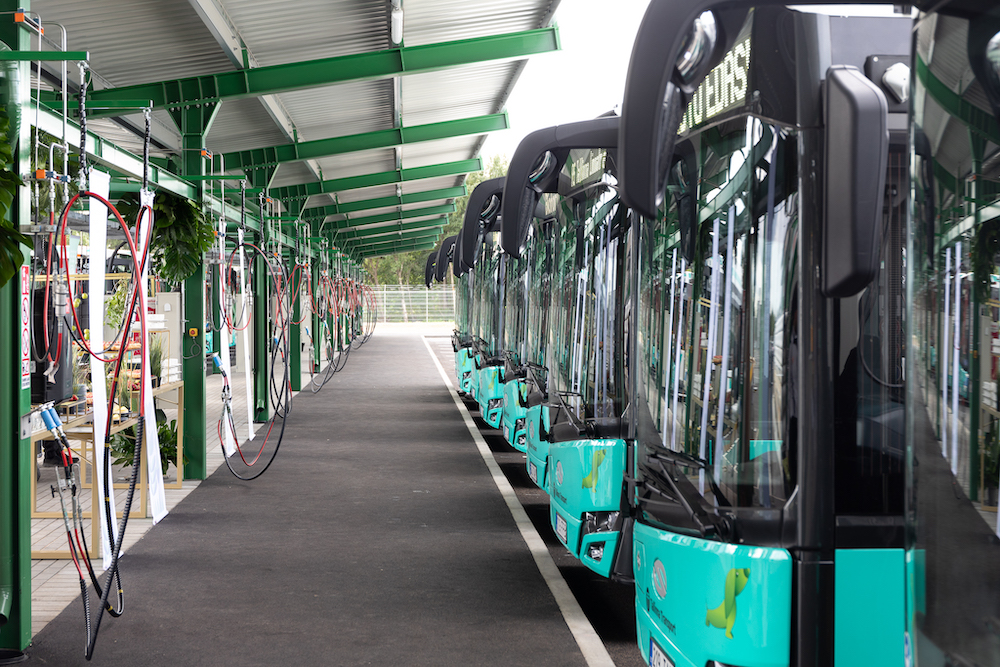The largest compressed gas filling station in the region was opened in Tallinn

On 20 July, AS Tallinna Linnatransport (TLT) and Bioforce Infra OÜ joined together in Tallinn to open the largest and most capable compressed gas filling station in the region. The filling station extends over a 25,000 square metre area. It includes 120 filling spots and two rapid gas pumps which supply compressed gas to the 200 public transport vehicles which are operating in the Estonian capital. This is the most powerful filling station of its kind in the Baltic states and Finland.
‘The transfer to gas buses and the development of the new infrastructure is a significant step in the development of an environmentally-friendly transport system for Tallinn, as well as for the whole of Estonia. The replacement of the current diesel fuel-based public transport vehicles with gas buses and the use of more sustainable fuels will support Tallinn’s goal to be a green capital. TLT and Tallinn’s government authorities have set out a common goal for 2025 to completely forego the use of diesel fuels. In addition to the environmentally-friendliness of the updated bus fleet, another significant advantage is that the fleet will make it possible to cut the cost of repairing and maintaining the old, worn-out infrastructure,’ said Andrei Novikov, deputy mayor of Tallinn.
Deniss Boroditš, chairman of the TLT management board, stressed the fact that the compressed gas filling station which has been built on Peterburi tee will advance the Estonian public transport sector to its next stage of development. ‘The modern bus terminal with its compressed gas filling station – the largest and most powerful in the region – is an important step forward in the development of the entire public transport sector. The transfer to gas buses has turned the transport system of the city of Tallinn into the largest consumer of compressed air in Estonia. Today, the capital is already being served by 200 compressed gas-fuelled buses, and a further 150 gas buses will be added within the next few years. It is important to highlight the fact that the planned 350 gas buses will consume approximately 200GWh of compressed gas each year. The transfer to the use of gas as fuel in the public transport sector may therefore be seen as the biggest sustainable innovation of the last few years. The increased demand will give manufacturers a reason to increase production volumes, while also promoting competition, and will therefore also make environmentally-friendly fuels more readily available,’ explained Boroditš.
The entire region’s largest compressed gas filling station, on Peterburi tee in Tallinn, was built by the winner of the gas procurement process for Tallinn’s public transport system, Bioforce Infra OÜ, in cooperation with Verston Ehitus. Henry Uljas, chairman of the Bioforce Infra OÜ management board, said that the brand-new compressed gas filling station also includes two rapid gas pumps in addition to the 120 slow filling spots. ‘While it is possible to simultaneously fill up to 120 vehicles in the slow filling area within a span of four hours, the process of filling a compressed gas-fuelled bus by using a rapid gas pump takes only six to eight minutes. While the capital’s public transport vehicles are primarily filled at night when passengers are not being transported, the filling station covers the needs of all of the 200 gas-using vehicles, Uljas pointed out, adding that they are also building a new station on Kadaka tee which will add another 200 slow-filling spots and three rapid gas pumps within a month from now.
Uljas added that biomethane production in Estonia has tripled in the last three years. ‘While there are already five biomethane production units in Estonia today, the next few years will certainly add at least three new biomethane stations to the market, as the need for environmentally-friendly and domestic biomethane will further be increasing. For example, Bioforce OÜ is building a new station in Aravete which will be producing approximately 35GWh of green gas a year. The cost of the investment is four million euros, and the new station should be launched next February,’ said Uljas.
The number of compressed air buses has reached two hundred
At the opening of the region’s largest gas filling station, TLT presented a selection of the new compressed gas buses which started running on city routes in July.
Seventy-five of the new buses are Urbino 12 buses, and eighteen are Urbino 18 articulated buses. Both vehicle types are equipped with 235kW engines which have been adjusted for running on compressed gas. The interior design and technical solution which was used on the buses have also been slightly updated, with now being able to use USB sockets to charge their smart devices during their journey. The buses are also equipped with security cameras to ensure safety and also expand the driver’s field of vision. These buses have automatic passenger counting systems fitted, which means they can load at least eighty passengers in the case of the Urbino 12, and at least 140 passengers in the case of the Urbino 18.
Unlike the older compressed gas buses, the new vehicles have fully enclosed driver’s cabs, which increase driver safety as well as improving the ergonomics of the workstation. The control panel on each of the new buses is now equipped with fire detection alarm buttons and reversing sensors. The driver is further assisted by rain and poor visibility sensors, for when they need to drive in poor weather conditions.

